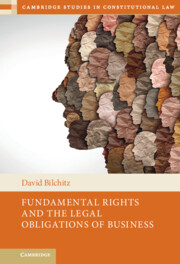Book contents
- Fundamental Rights and the Legal Obligations of Business
- Cambridge Studies in Constitutional Law
- Fundamental Rights and the Legal Obligations of Business
- Copyright page
- Dedication
- Contents
- Figures
- Tables
- Preface
- Acknowledgements
- Table of Cases
- Introduction The Question of Substantive Corporate Obligations for Fundamental Rights
- 1 The Nature and Purpose of the Corporation in Law
- Part I Legal Doctrinal Models for Addressing the Substantive Obligations of Non-State Actors for Fundamental Rights
- 2 The State Duty to Protect Model
- 3 The Indirect Application Model
- 4 The Expanding the State Model
- 5 The Direct Obligations Model
- Part II Towards a Multi-Factoral Approach for Determining the Substantive Content of Corporate Obligations
- Part III The Institutional Implications of the Multi-Factoral Approach
- Bibliography
- Index
4 - The Expanding the State Model
from Part I - Legal Doctrinal Models for Addressing the Substantive Obligations of Non-State Actors for Fundamental Rights
Published online by Cambridge University Press: 29 October 2021
- Fundamental Rights and the Legal Obligations of Business
- Cambridge Studies in Constitutional Law
- Fundamental Rights and the Legal Obligations of Business
- Copyright page
- Dedication
- Contents
- Figures
- Tables
- Preface
- Acknowledgements
- Table of Cases
- Introduction The Question of Substantive Corporate Obligations for Fundamental Rights
- 1 The Nature and Purpose of the Corporation in Law
- Part I Legal Doctrinal Models for Addressing the Substantive Obligations of Non-State Actors for Fundamental Rights
- 2 The State Duty to Protect Model
- 3 The Indirect Application Model
- 4 The Expanding the State Model
- 5 The Direct Obligations Model
- Part II Towards a Multi-Factoral Approach for Determining the Substantive Content of Corporate Obligations
- Part III The Institutional Implications of the Multi-Factoral Approach
- Bibliography
- Index
Summary
This chapter considers the ‘expanding the state model’ which limits the obligations flowing from fundamental rights to the state and only imposes obligations on non-state actors if they are, in some sense, state-like. This model fundamentally raises the question of what constitutes part of the state and, in so doing, provides an understanding of the determinants for having obligations. I argue the model focuses on the wrong issue: which agents are part of the state rather than the factors that are relevant to determining obligations. The chapter also examines the model as it is expressed through the case law of three jurisdictions – the United States, Germany and South Africa. In doing so, I explore the factors the courts employ to determine whether an entity or function is state-like and their implications for obligations. Those factors overlap with those identified in the other models – which, in turn suggests, the artificiality of confining the application of rights only to state actors.
Keywords
- Type
- Chapter
- Information
- Fundamental Rights and the Legal Obligations of Business , pp. 135 - 174Publisher: Cambridge University PressPrint publication year: 2021

